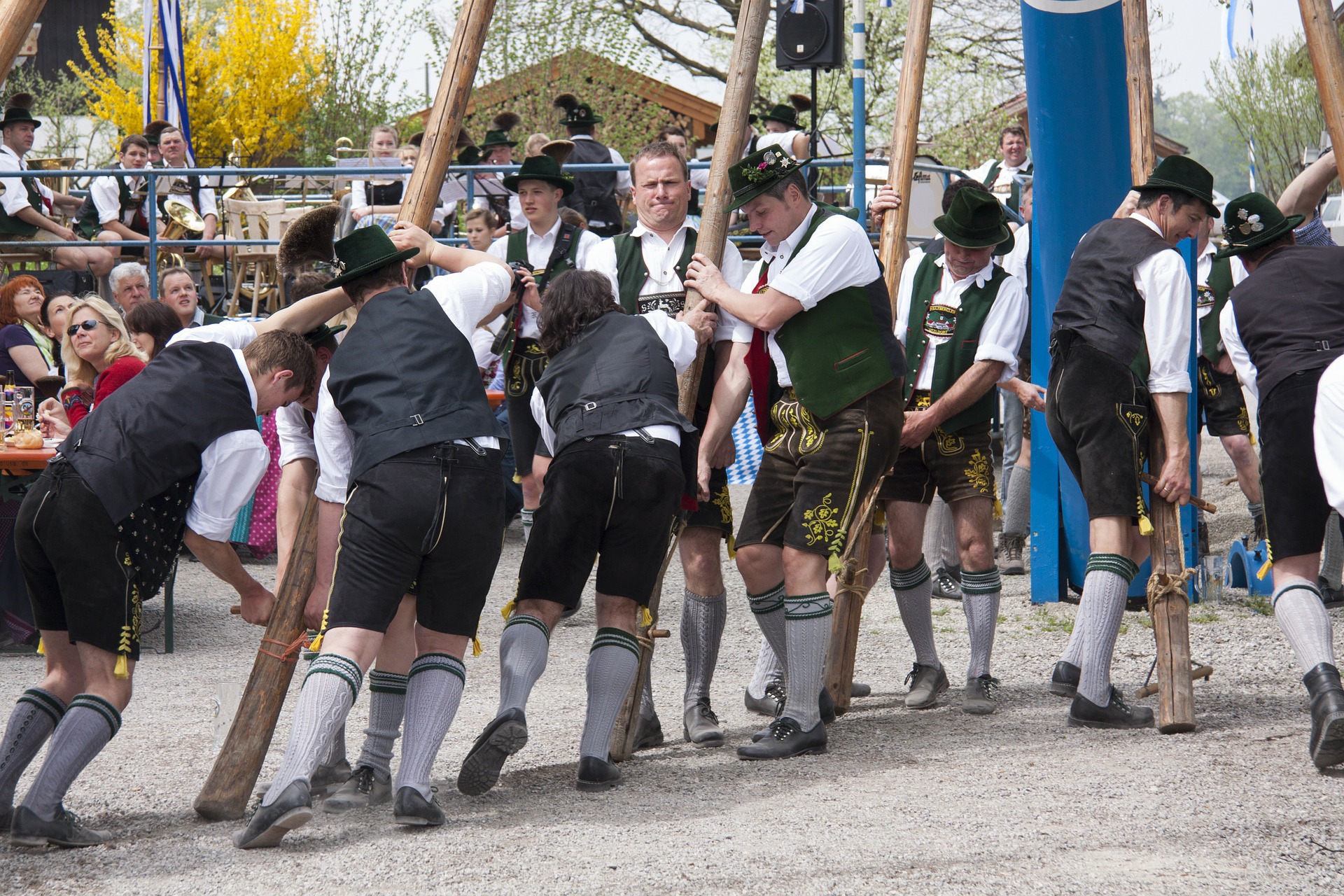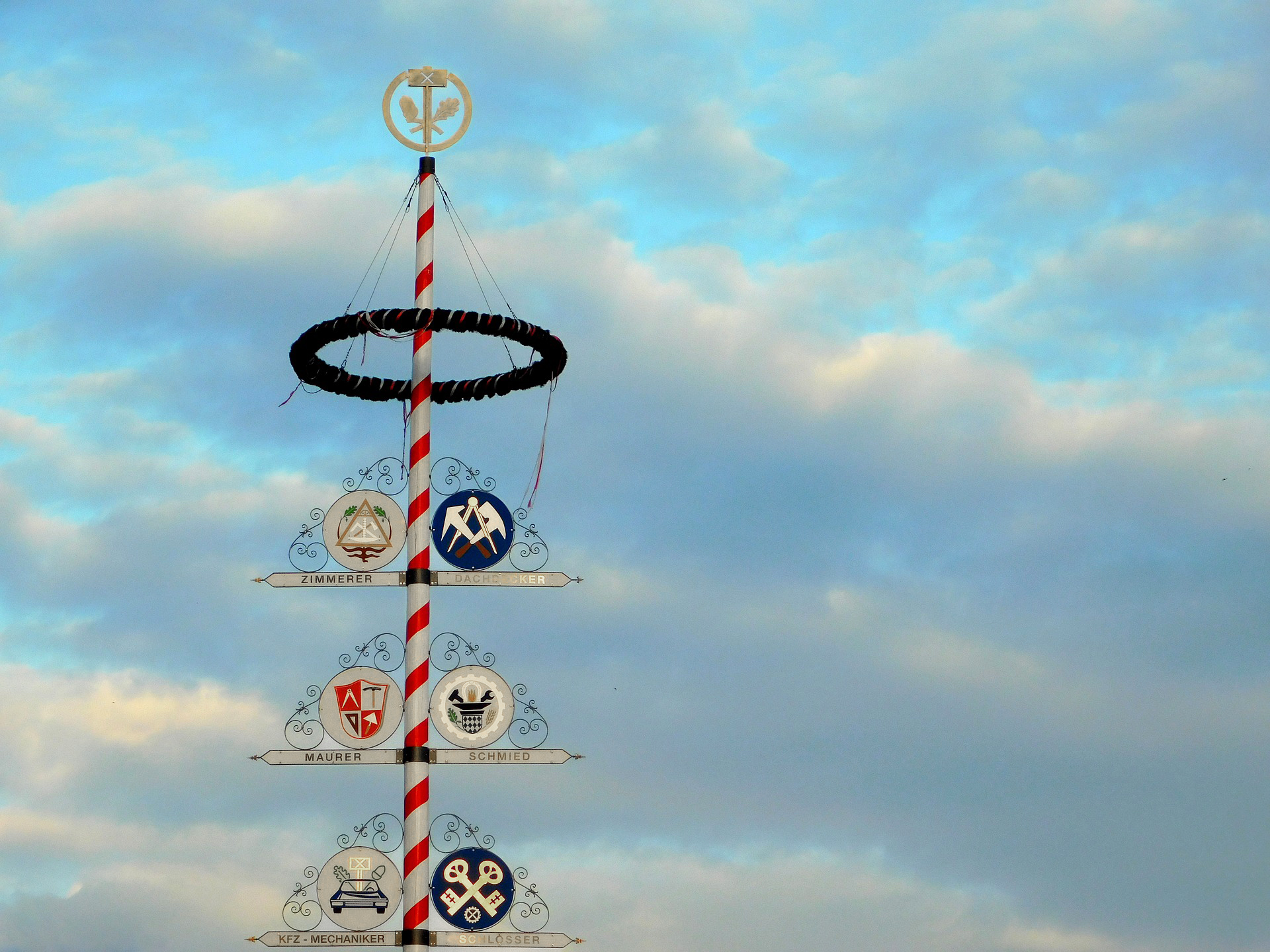Fahnen Kössinger, April 2019
Setting up a Maypole - a dying tradition?
Uncertain origins
Much research has been done on the customs and origins of the maypole. So far, however, no historian has been able to determine the exact origins. In large cities where written evidence would be more common, the custom was hardly carried out, and in the more rural villages, there were no historians interested in records of festival customs.
Allegedly pagan fertility customs with the tree as a phallus symbol have often been cited, as well as village festivals held to mediate marriage between the young people of the village. The latter is still common today. In some areas, male and female singles distribute small decorated may trees or attach a tree decorated with colored paper to the house of the beloved.
In the course of the centuries, the Catholic church forbid the setting up of a maypole again and again, probably, as a precautionary measure, in order to avoid overflowing celebrations and to prevent thoughts of pagan fertility rites from the outset.
During the Romantic period in the 19th century, in a transfigured way, the maypole was seen as a symbol for rich harvests and fertility, which, however, could never be proven historically.
A custom in many regions
May 1 is almost a worldwide holiday, nowadays it is mostly celebrated by law as Labor Day. In many European countries the custom of putting up a decorated tree is known. No matter whether in Scandinavia (there rather around Midsummer Night) or in Germany, Austria or Switzerland - always the erection of a spruce trunk is connected with a celebration in which the entire village takes part.
The decoration
Traditionally, a maypole is planted the day before or directly on May 1. The decoration of the tree symbolizes at the same time the wealth of the respective place and, by its green top and the winding wreaths, it stands for the fertility and the growth of flora and fauna, which is particularly important in agriculturally characterized areas. Here, however, there is still a reference to old pagan customs - people hoped for protection from any disaster, be it in the form of thunderstorms or vermin.
Although the medieval guilds no longer exist, they live on in the shield which are almost always attached to the right and left of the often blue-white or red-white coiled spruce trunks. The richer a village was, the more splendid were the coats of arms and panels of the guilds. At first only carved from wood and colorfully painted, they later began to attach metal signs to the trunk, as these were also more durable.
Around the setting up of the tree
Here the traditions are particularly fixed, as they influence the honor of the lads who are normally responsible for cutting, transporting, guarding and erecting the tree. For some years now, women's groups have started to penetrate this male domain, which many gentlemen are strictly rejecting. The gender debate no longer stops at such traditional events.
At first, days before the festival, a tree is selected from a surrounding forest, cut down there and taken into the village, mostly with musical accompaniment. The village youth, who are responsible for the festival, decorate the tree with wreaths around which green garlands and colorful ribbons are wound. The traditional guild and handicraft symbols are applied. In some places of Bavaria, the maypole is painted with a blue-white or red-white spiral. This runs from the bottom left to the top right. The blue-white color is reminiscent of the Bavarian flag, red-white of the Franconian rake
Beware of thieves
Until the actual festival, the decorated tree must be carefully guarded. Boys' associations or other groups from the neighboring communities try to steal the good piece and only give it back if an appropriate release is paid. Most of the time it's about beer and a good snack. The rules of maypole stealing have only been handed down orally, but their observance is still a matter of honor. Only already felled trees may be stolen, and these only from the village, not already in the forest. If the thieves are caught, they may neither use force nor saw up the tree or damage it in any other way. After the ransom is paid, the tree must be returned undamaged. Once set up, it is off-limits to thieves.
Muscle strength is required
The boys and increasingly also girls or firefighters want to keep up the traditions as unadulterated as possible and erect the maypole with pure muscle power. With pairs of wooden poles, so-called Schwaiberln or Schar-/Scherstangen they lift the tree into the vertical and fix it in a prepared recess on the village or market place. To be on the safe side, many clubs already use cranes to secure the heavy trunks.

Laws as a killer of tradition?
The manual work of erecting the May poles involves an increased risk of accidents despite the support provided by machines. It is therefore becoming increasingly difficult for the organisers to find insurance that covers possible damage to property or personal injury. The communities also do not want to be held responsible. For this reason, more and more of the traditional May festivals are falling victim to the legal requirements that are difficult or impossible to meet. Tree heights of more than 50 meters do their part to deter insurance companies and authorities.
Smaller trees as an alternative are rejected by the associations as ridiculous, and not even the increasing support by forklifts, cranes or trucks appeases the insurance representatives. It would be a pity if the May festivals with their traditional customs were to die out as a result.
Old traditions revived
But there is hope that the old customs can also be saved into modern times. In Munich, social and cultural institutions create a pink maypole. It symbolizes the diversity of the Glockenbach district and is also celebrated with an annual festival where traditional music is played and the entire district comes together. The maypole shields are created by an artist. The Bayerische Landesverein für Heimatpflege (Bavarian National Association for Homeland Care) also takes a positive view of this new type of Maypole tradition. One can only hope that a solution will be found to the insurance problems that still leaves enough room for the old traditions to unfold.

 English
English  Deutsch
Deutsch 
